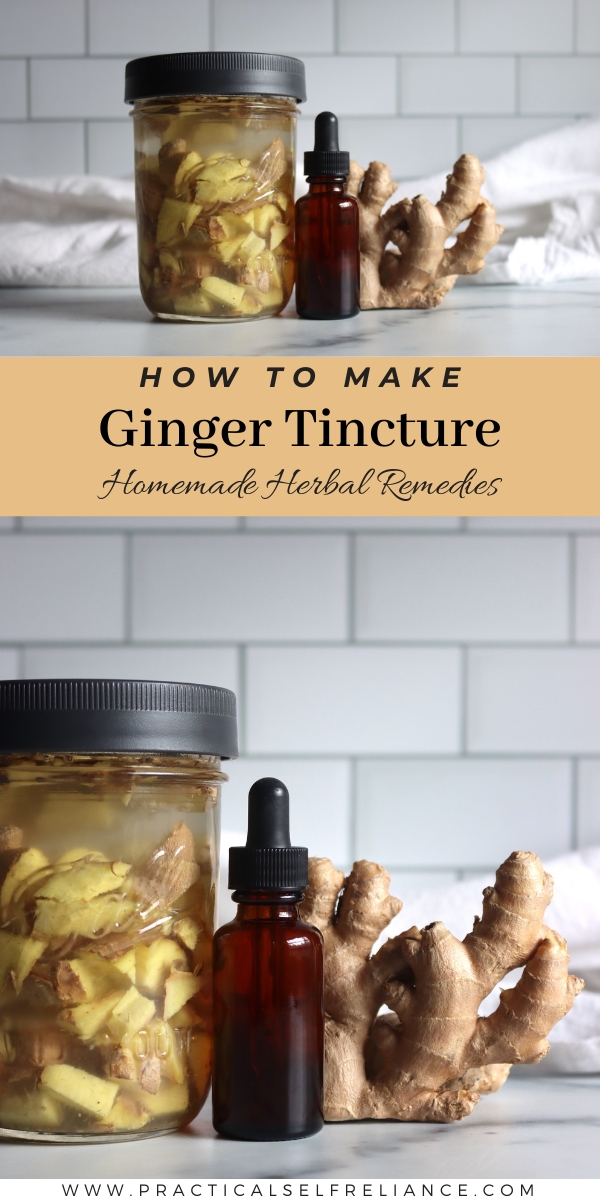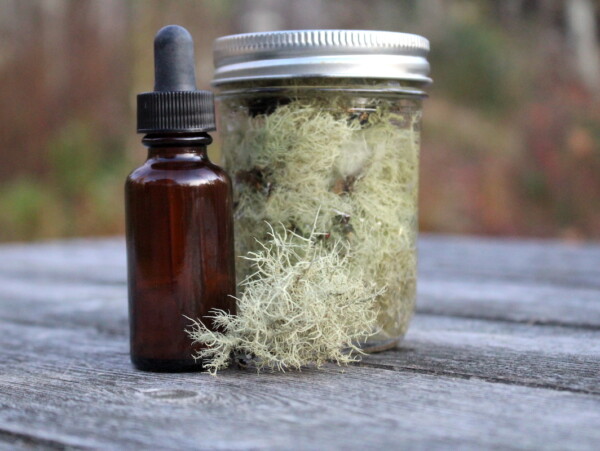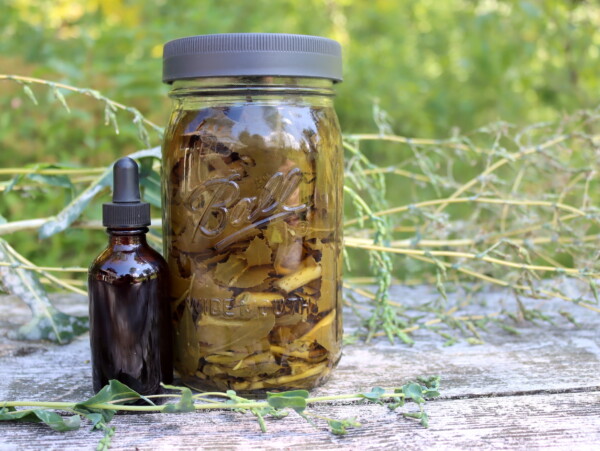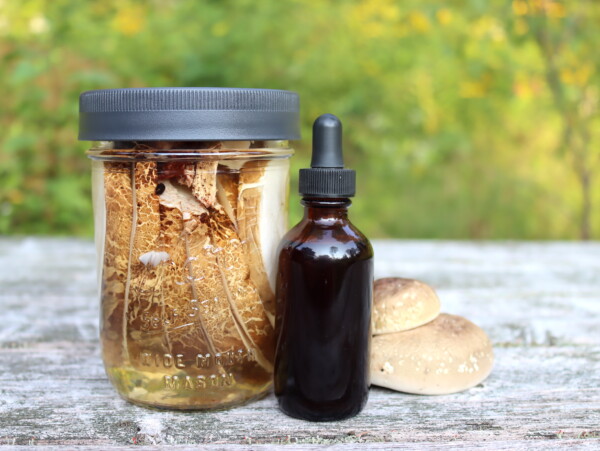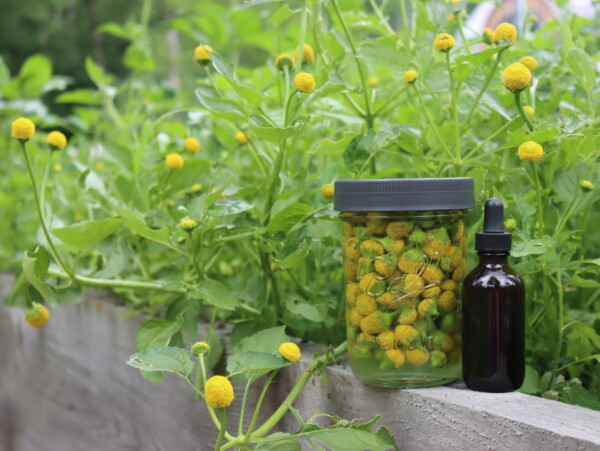Affiliate disclosure: This post may contain affiliate links. Please see our Privacy Policy.
Ginger tincture is a warm, soothing herbal treatment for nausea, indigestion, bloating, gas cramping, morning sickness, and motion sickness. It also has anti-inflammatory and anti-viral properties. It’s an excellent choice to help boost the immune system and fight illnesses like colds and flu. It’s also helpful for reducing the symptoms of chronic inflammatory conditions like arthritis. Thankfully, this helpful tincture is easy to make.
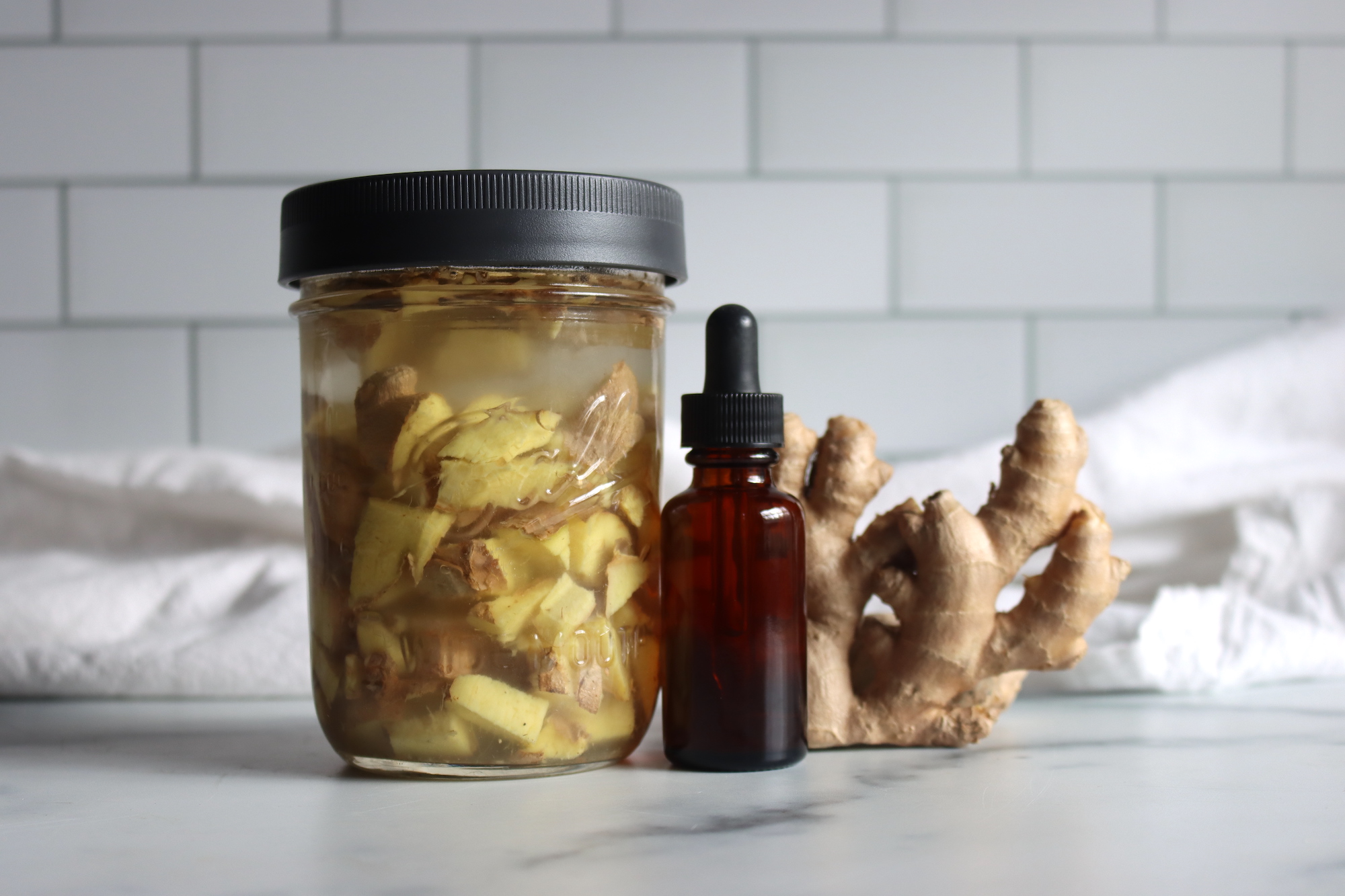
Ginger is one of the few herbal allies that many of us already use and enjoy. Its warming properties and pleasant spiced flavor make it a popular choice for herbal remedies and winter treats.
Ginger is probably best known as an herbal remedy for treating nausea. It’s great to have on road trips or boat excursions when you may become car or seasick. It’s also a great herbal remedy for expecting mothers dealing with morning sickness, though large doses should be avoided if you’re pregnant.
Ginger’s benefits don’t stop there, though. With significant immune-supporting, anti-inflammatory, antiviral, circulatory, and antispasmodic properties, ginger tincture is a good choice for many conditions.
Generally, folks purchase ginger rhizomes from their local grocery or health food store. However, you can grow your own ginger, too, even in northern climates. You can start your ginger plants from organic rhizomes from the grocery store or order special varieties from some seed and plant retailers.
In cold areas, grow ginger in pots. That way, you can move them indoors or into a greenhouse when cold weather threatens. The rhizomes send up attract grassy, almost bamboo-like plants that make lovely potted plants for a sunny window or porch.
Ginger can take up to 8 to 10 months to reach its full size, but you can harvest it anytime after the rhizomes begin to form. It’s a bit like harvesting potatoes early for the small baby potatoes.
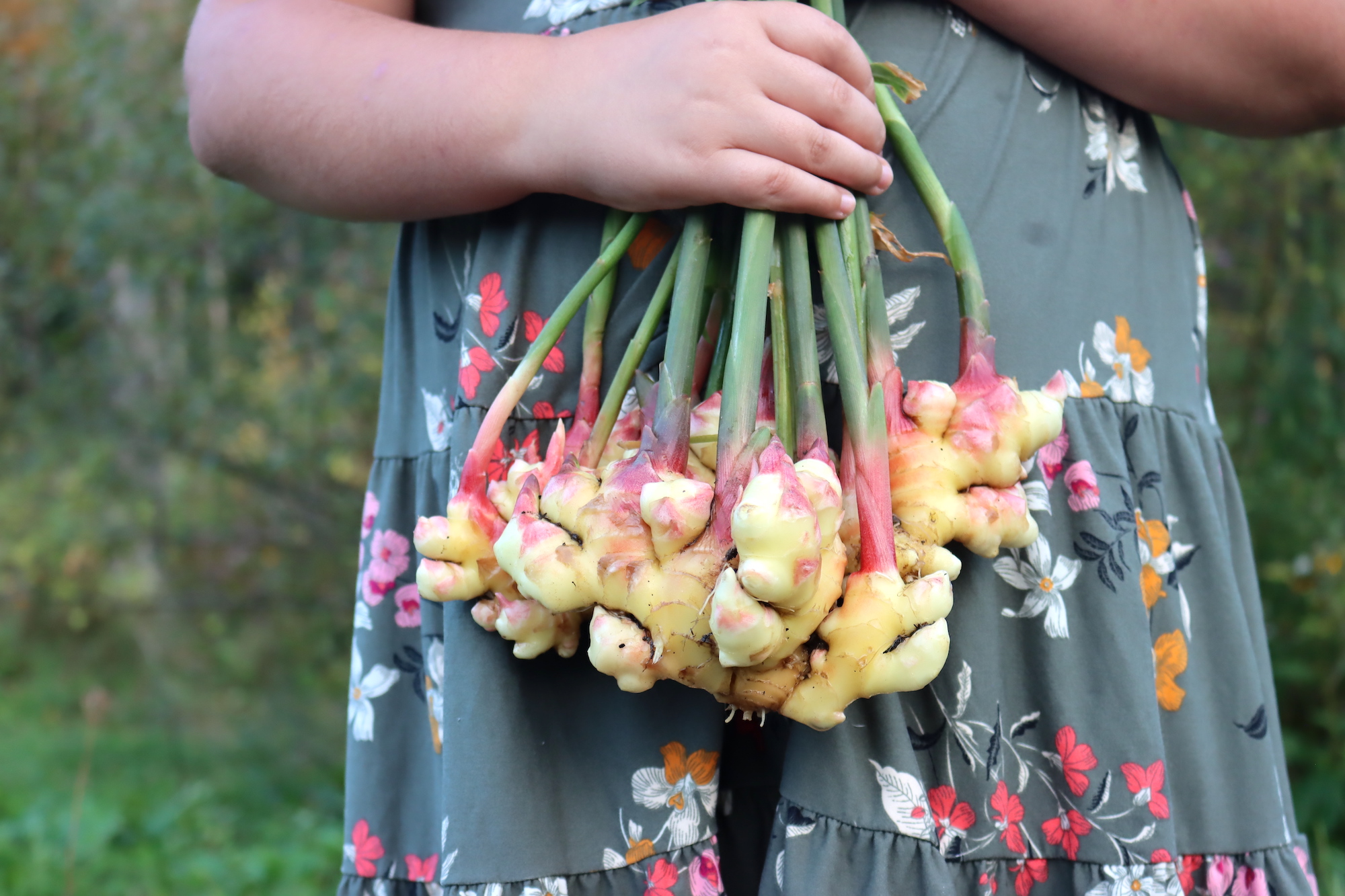
Tincture Tincture Uses
Herbalists use ginger tinctures both topically and internally to treat various ailments.
Topically, ginger tincture is used for:
- Treat arthritis and osteoarthritis
- Reduce inflammation
- Improve circulation
- Reduce muscle spasms
Internally, Ginger tincture is used to:
- Treat nausea and indigestion
- Boost the immune system
- Treat colds, flu, and other viral infections (through immune support)
- Stimulate the appetite
Additionally, the herb is currently being investigated for its potential:
- Prevent Heart Disease
- Diabetes Treatment
- Reduce Menstrual Pain
A few studies have demonstrated ginger’s use for these ailments, but further study is needed to verify their significance.
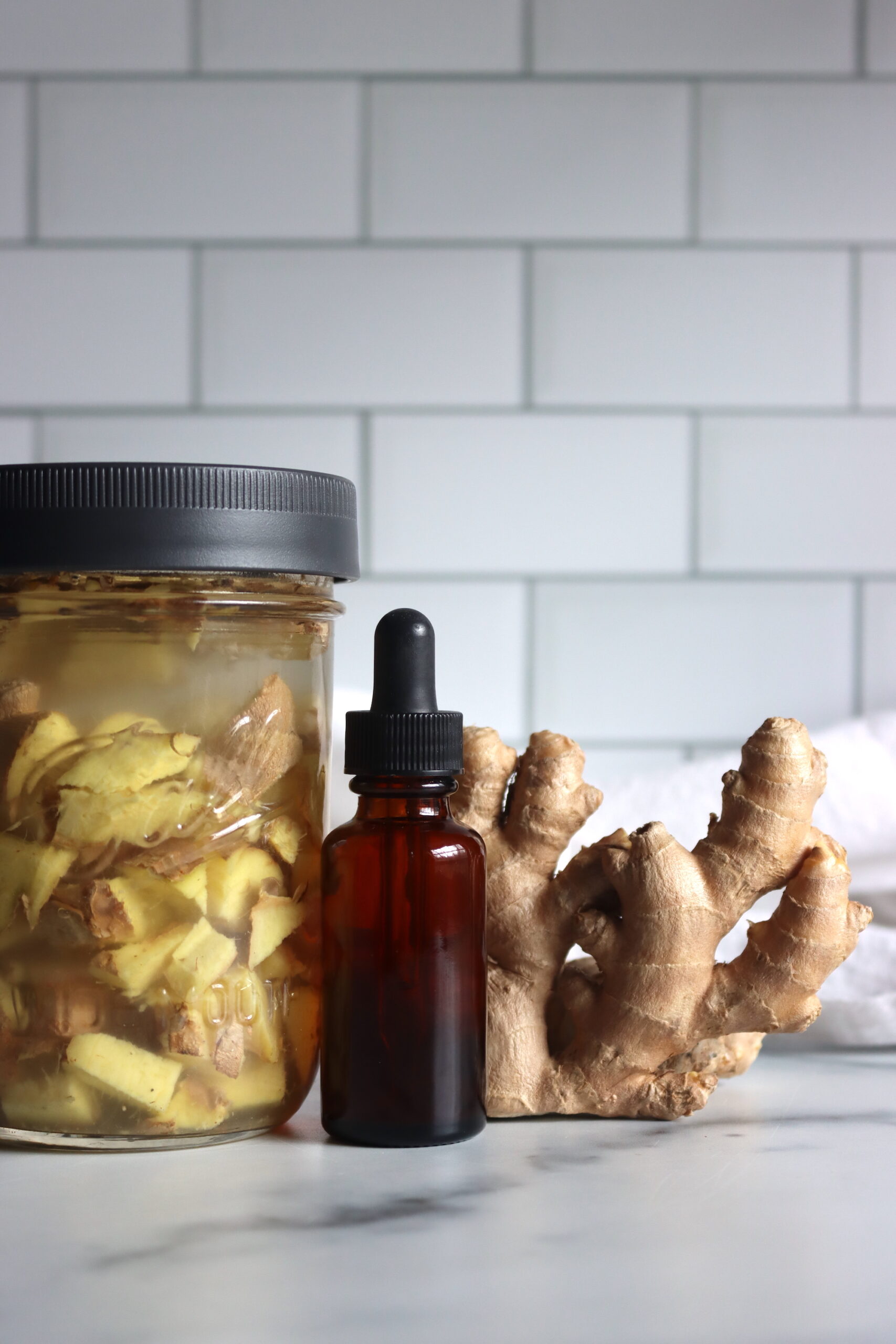
Benefits of Ginger Tincture
Herbalists usually reach for ginger to treat various types of nausea and indigestion including chronic conditions. Traditionally, herbalists around the world have reached for ginger when they need to soothe upset stomachs from temporary conditions like motion sickness or recurring nausea like that caused by pregnancy or IBS.
One excellent way modern researchers are using this anti-nausea property is by treating the nausea associated with chemotherapy. A 2011 study that looked at 576 patients undergoing chemotherapy found that those patients given ginger rather than a placebo reported significant reductions in nausea.
While ginger may be best known for treating nausea, herbalists have also used this warming tincture to treat the pain and inflammation associated with arthritis. Herbalists may use the tincture both internally and externally on the site of the pain and inflammation. It’s thought that ginger may improve circulation in these areas.
Modern studies are beginning to explore this age-old traditional remedy. One study found that ginger extract helped to reduce knee pain in patients with osteoarthritis.
Ginger tincture is also a historic remedy for colds, cases of flu, and viral infections. We often reach for ginger more both as a culinary and medicinal herb as we head into the fall and winter flu season, and with good reason!
Ginger may have significant antiviral properties and help support the immune system. One study found that it has antiviral activities against RSV (Respiratory Syncytial Virus), which can cause serious illness in young children, older adults, and those with underlying health conditions.
Another interesting study found that daily ginger consumption is associated with a lower risk of heart disease. Daily ginger intake may also help control blood sugar levels in people with type 2 diabetes.
Lastly, modern studies have begun exploring ginger as a treatment for painful, heavy menstrual cycles. One particularly promising study followed 92 high school-age girls who reported heavy menstrual bleeding. Half were given ginger, and half were given a placebo. Those who received ginger reported a dramatic decrease in blood loss over six menstrual cycles.
Ginger tincture is a great remedy to take as needed for the occasional nausea. For more chronic conditions, you can take a dropper full or about 0.8 to 1.5ml (1 to 1.5 dropper full) up to 3 times per day. Ginger is generally well tolerated, but it’s best to start with a small amount and increase it until you find what works for you. The specific dosage varies with your intended use.
Parts Used for Tincture
When making a ginger tincture, you use the ginger rhizome. The rhizome is a type of underground stem and is “ginger root” you may be familiar with purchasing for culinary use.
Slicing, roughly chopping, or shredding your ginger helps the tincture process by allowing the alcohol more surface area to soak into the ginger.
If you don’t have fresh ginger rhizomes available, you can also purchase dried ginger. You don’t want the powder that’s found in the spice section; it’s probably not very fresh and is difficult to work with. Instead, purchase dried ginger rhizome pieces from a specialty herb store like Mountain Rose Herbs.
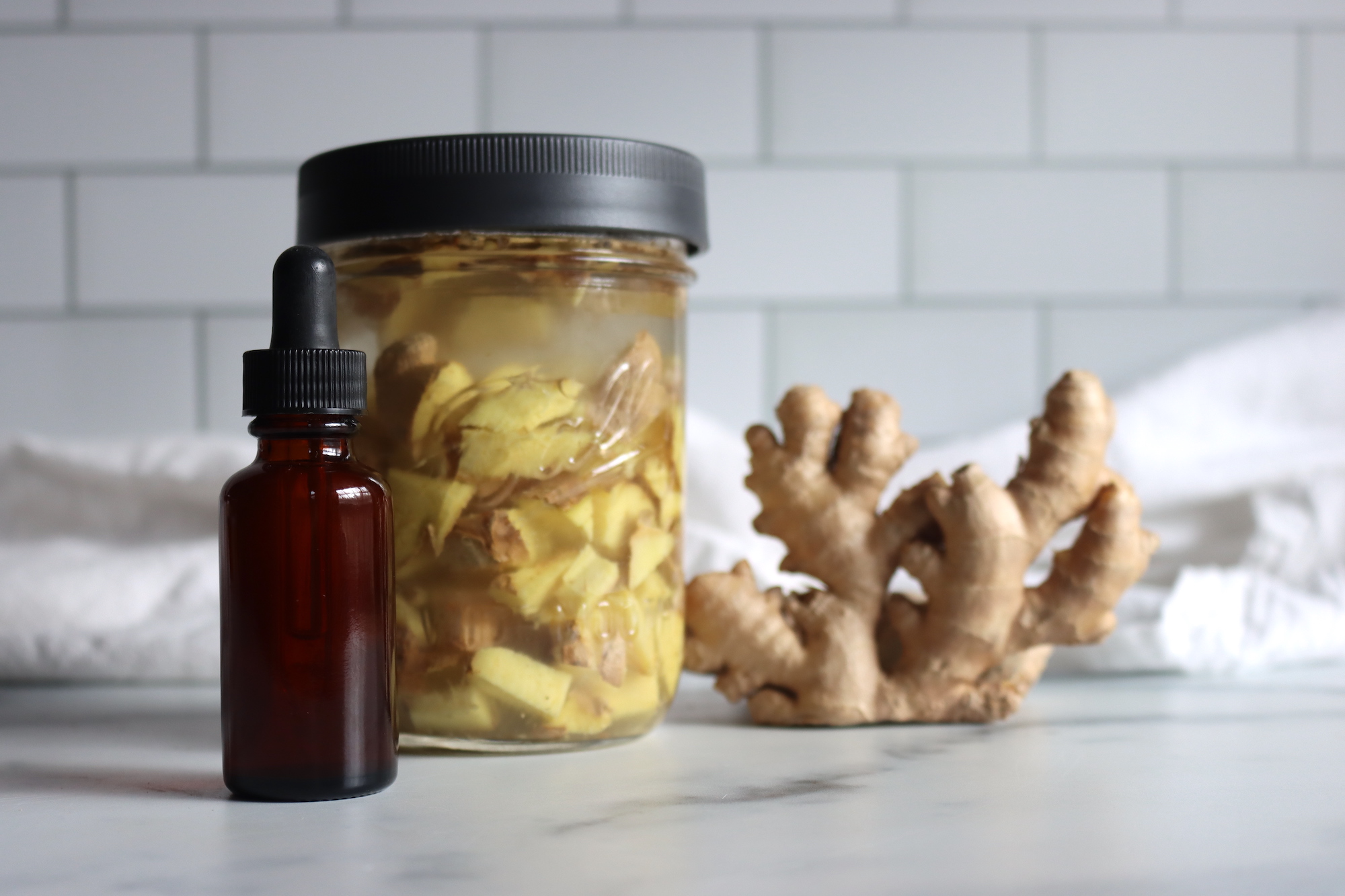
How to Make Ginger Tincture
To make a Ginger tincture, you’ll need the following ingredients and equipment:
- Fresh or dried ginger rhizome
- Vodka* (or any other palatable alcohol)
- One-pint mason jar with lid (amber glass is ideal, but as long as you keep the tincture away from light at all times, it won’t make a difference)
- Funnel
- Cheesecloth
- Fine mesh sieve
- Amber glass tincture bottles (with dropper)
*The Herbal Academy’s tincture-making course recommends using 70% to 95% alcohol when working with fresh ginger or 40% alcohol when working with dried ginger.
**Never use isopropyl/rubbing alcohol for tinctures (or any other remedy you plan on ingesting). Even in small amounts, this type of alcohol is toxic and meant for external applications only.
To make the tincture, add fill a jar about 3/4 of the way full with fresh ginger (or about ¼ full with dried ginger).
Cover the ginger with vodka or whichever alcohol you’ve chosen, and seal the jar with its lid.
Place your jar somewhere cool and dark, but don’t hide it away where you will forget it. You need to shake your tincture regularly. It’s best to gently shake your tincture once a day, but tinctures are forgiving, and every couple of days will work, too.
After about 4 to 6 weeks, your tincture is ready for decanting!
To do this, line a funnel with cheesecloth. Carefully strain the tincture, then squeeze your ginger in the cheesecloth to ensure all the liquid is expelled.
At this stage, you can bottle your tincture or let it settle overnight and use a finer filter or sieve to remove any additional material.
Once you’re happy with your tincture, pour it into small amber glass tincture bottles.
Label the tincture bottles with the date and suggested dosages (I use a small piece of masking tape and a marker; it peels off easily when I’m ready to use the bottle for something else).
Ginger Tincture Dosage
I’d suggest consulting a clinical herbalist for an exact dosage specific to your body and needs.
Generally, the dosage for ginger tincture is 1 to 1.5 droppers full (0.8 to 1.5ml), taken 2 to 3 times per day or as needed.
Ginger Formulations
Ginger is often used with other warming herbs that encourage good circulation. Try using ginger tincture in combination with cinnamon, clove, or turmeric. When used for nausea, try other common soothing digestive herbs like a peppermint tincture or a chamomile tincture.
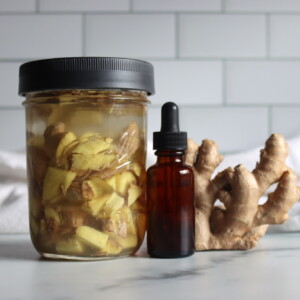
Ginger Tincture
Equipment
- Dark glass bottles for storage
Ingredients
- Fresh or dried ginger root
- High-proof alcohol vodka, brandy, or rum
Instructions
- If you’re using fresh ginger, start by scrubbing the root well to remove any dirt. You can peel it if you prefer, though it's not necessary. Slice the root into thin pieces or small chunks to increase the surface area, allowing the alcohol to better extract the beneficial compounds. If you’re using dried ginger powder, add it to the jar.
- Pack your mason jar about halfway full with fresh ginger pieces or 1/3 full if you’re using dried ginger. It’s important not to overpack the jar, as the alcohol needs room to circulate and extract the medicinal properties.
- Pour your choice of high-proof alcohol (vodka is common, but brandy or rum will work well too) into the jar, ensuring the ginger root is completely submerged. Add enough alcohol to cover the ginger completely, leaving about an inch of space at the top.
- Tighten the lid securely and give the jar a good shake to mix the ginger with the alcohol. Store the jar in a cool, dark place for 4 to 6 weeks. During this time, the alcohol will slowly extract the ginger’s volatile oils, antioxidants, and anti-inflammatory compounds.
- Every 2 to 3 days, gently shake the jar to help agitate the ingredients and encourage the extraction process. If you notice that the ginger root has floated above the alcohol, top off the jar with more alcohol to ensure the root remains submerged.
- After 4 to 6 weeks, it’s time to strain the tincture. Set up a funnel lined with cheesecloth or use a fine mesh strainer to filter the liquid into a clean container or dark glass bottles. Press the ginger to extract as much of the liquid as possible. You may want to strain the tincture twice if you prefer a clearer liquid.
- Transfer the strained tincture into dark glass storage bottles. Be sure to label the bottles with the contents, the date it was made, and any dosage information. Store your ginger tincture in a cool, dry location, away from direct sunlight.
Notes
Uses
Ginger tincture is a versatile and convenient herbal remedy that can be used both internally and externally. Here are a few common uses: For Digestive Support: Ginger is well-known for its ability to soothe the stomach and aid in digestion. For Inflammation and Pain Relief: The anti-inflammatory compounds in ginger make it a great option for supporting joint health and reducing pain. For Respiratory Health: Ginger’s warming and circulatory-stimulating properties make it beneficial for respiratory health. For Circulation and Energy: Ginger is also known to boost circulation and increase energy levels.Alcohol-Free Option: Ginger Glycerite Tincture
If you prefer an alcohol-free tincture, you can make a glycerite tincture using vegetable glycerin. Here’s how:- For Dried Ginger: Mix 3 parts vegetable glycerin with 1 part distilled water.
- For Fresh Ginger: Use 100% vegetable glycerin (no need for water).
Yield and Storage
Fresh vs. Dried Ginger: If you're using fresh ginger, expect to pull out slightly more tincture than the amount of alcohol you initially added, as fresh root contains moisture. Dried ginger, on the other hand, may absorb some of the alcohol, resulting in slightly less tincture than the amount you started with. Amount of Alcohol: For a quart-sized mason jar, you’ll typically need around 2 to 3 cups of alcohol. For a pint jar, 1 to 1.5 cups should be sufficient. Always make sure the ginger root stays submerged throughout the infusion process. Storage: Ginger tincture can be stored for several years if kept in a cool, dark place. For best results, keep it out of direct sunlight and in an area with stable temperature.Tincture Recipes
Looking for more homemade herbal tinctures?
